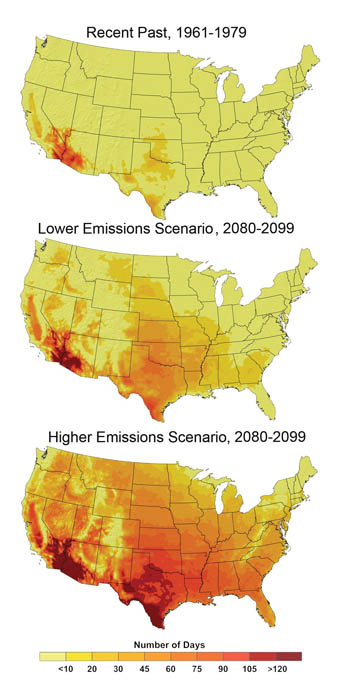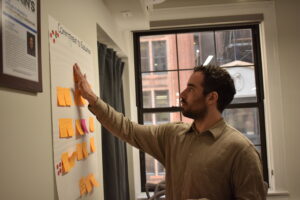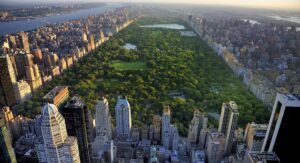It’s hot out there
New York City and the surrounding area saw a record-breaking heat wave at the end of July. Newark, New Jersey saw five straight days of temperatures over 100-degrees, the longest such streak ever. Sweltering temperatures are a real threat–extreme heat is the most common weather-related cause of death in the United States, and climate change is only increasing the frequency of heat waves. The Environmental Protection Agency published the following graphic showing how two different emissions scenarios could increase the number of days above 100-degrees. In either case, the continental United States is likely to experience more and more extremely hot days.

Heat waves are a particular challenge in a dense urban environment like New York City. Heat waves in places like New York City are exacerbated by the “urban heat island effect.” Densely packed buildings, asphalt streets, and a lack of greenery can cause temperatures to rise because these surfaces absorb and retain heat. A recent study found that New York City ranked third highest in heat island intensity in the United States due to its building height, use of impermeable materials, and population density. It followed New Orleans, Louisiana and Newark, New Jersey.
Across the country, heat waves often disproportionately impact communities of color and low-income communities due to a variety of factors. In New York City, less than half the city’s public housing residents have air conditioning. Trees, which mitigate the heat island effect by providing shade and releasing moisture into the atmosphere through transpiration, are not distributed evenly across the city. A 2021 study showed wealthy neighborhoods in New York City typically have more trees than low-income neighborhoods. Hunts Point, a neighborhood in the South Bronx with a poverty rate of 39.6%, has a tree coverage rate as low as 4.8%, while Brooklyn Community District 2, which includes wealthy Brooklyn Heights and Fort Greene and has a median household income of $106,992, was found to have an average tree cover of about 25%. NYC’s Mapping Equity map, shown below, illustrates that many low-income neighborhoods have a high Heat Vulnerability Index. These inequities make heat waves disproportionately dangerous to these under-resourced communities.

Looking to a high-heat future
So how is New York responding to these challenges? New York State is offering a Cooling Assistance benefit that offers up to $800 for fan and air conditioner installation to eligible households. In May 2020, Mayor de Blasio launched the Get Cool NYC Program, which would provide 74,000 free air conditioners to low-income seniors in New York City. However, as of July, many seniors that applied for the program had not received their air conditioners. NYC residents also have access to the Cooling Center Program. On heat emergency days, New York City residents can go to community centers, public libraries, or other public facilities to access air conditioning and other beat-the-heat resources. New Yorkers can also cool off the old-fashioned way by asking ask local firehouses to uncap a fire hydrant and fit it with a spray cap.
Infrastructure plays a key role in both the problem and the solution to extreme heat. Existing buildings, roads, and public spaces in New York City’s most heat-vulnerable neighborhoods often contribute to the problem of extreme heat. Pavement, parking lots, and building roofs are often dark-colored and absorb heat. Greenery on sidewalks also provides key areas for cooling communities if implemented on a larger scale. The city’s Cool Neighborhoods NYC program has created a comprehensive plan for redeveloping street and community infrastructure to better combat extreme heat. This includes painting asphalt and building roofs with less heat-absorbing colors; adding greenery to streets and sidewalks; and continuing the legacy of Million Trees NYC by investing $82 million in street tree planting in vulnerable communities. These infrastructure investments are meaningful steps towards curbing the urban heat island effect and cooling NYC communities. Each of these steps is part of a larger “retrofitting” process in which existing buildings have sustainable infrastructure incorporated, rather than rebuilding structures completely, and provides a bridge to a sustainable future. Retrofitting for heat includes repainting and repaving but can also encompass other sustainable solutions such as improving insulation, updating HVAC systems, adding green roofs, and other solutions that don’t involve tearing down and rebuilding. Looking to the future, infrastructure investments will likely need to go bigger. Envisioning and designing whole neighborhoods to mitigate heat effects by providing a bridge through retrofitting can have significant sustainability impacts.
Columbia University published a recent study offering a series of recommendations for improving heat resiliency in New York City. Amongst these recommendations, they suggested planting more vegetation and expanding green spaces; scaling up heat mitigation programs, in particular focusing on solutions to issues that disproportionately affect low-income communities; and improving communication and community engagement in heat resiliency efforts. Communities know better than anyone how heat affects their daily lives. WE ACT for Environmental Justice, an environmental advocacy group in New York City, has conducted community reporting on heat and its health effects on residents. Organizations like this can play a vital role in elevating the voices of NYC residents. Engagement should be a pillar of the City’s effort to combat extreme heat. Whether it’s the implementation of a revived Get Cool NYC program, an expansion of Cooling Assistance Benefits, or the retrofitting of NYCHA buildings with more sustainable, accessible cooling solutions, residents should play an integral role in the planning and implementation of these efforts.
New York City has ramped up its efforts to fight climate change in recent years. From expanding city renewable energy sourcing to committing to sustainable transportation and electric vehicle implementation, NYC has positioned itself to be a leader in combating the climate crisis. Resiliency efforts are in progress to ensure the city can continue to grow and thrive as we work to curb emissions around the world. As heat becomes a seriously dangerous prospect for many New Yorkers, a continued focus on equity as well as a future vision for a more heat-resilient city should guide the effort. NYC can look to cities like Medellín and São Paulo, which are highlighted in C40’s City Knowledge Hub for their renewal efforts in developing green corridors to help cool the city. Washington, DC was recently ranked #1 in the Trust for Public Land’s 2022 Park Score, which, for the first time, included an equity component where DC scored an 87/100. In comparison, New York City scored a 75/100 on the equity component.
Developing a heat-resilient future for New York City will require the engagement of all city agencies and the utilization of resources from across NYC’s diverse economy and community. Top-down city government solutions are appealing, but developing leadership amongst the private sector and within communities and neighborhoods will be essential for mitigating the effects of climate change and extreme heat over the next few decades. Public-Private Partnerships, community partnerships, and coalition-building are examples of solutions that NYC government can use to build bridges and create a more inclusive effort to combat the effects of climate change. After all, as Canadian philosopher Marshall McLuhan said, “There are no passengers on spaceship Earth. We are all crew.”





 Public Works Partners is a WBE/DBE-certified urban planning and consulting firm. Our expertise lies in creating innovative, equitable, and sustainable solutions to complex problems.
Public Works Partners is a WBE/DBE-certified urban planning and consulting firm. Our expertise lies in creating innovative, equitable, and sustainable solutions to complex problems.